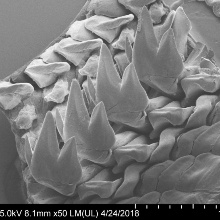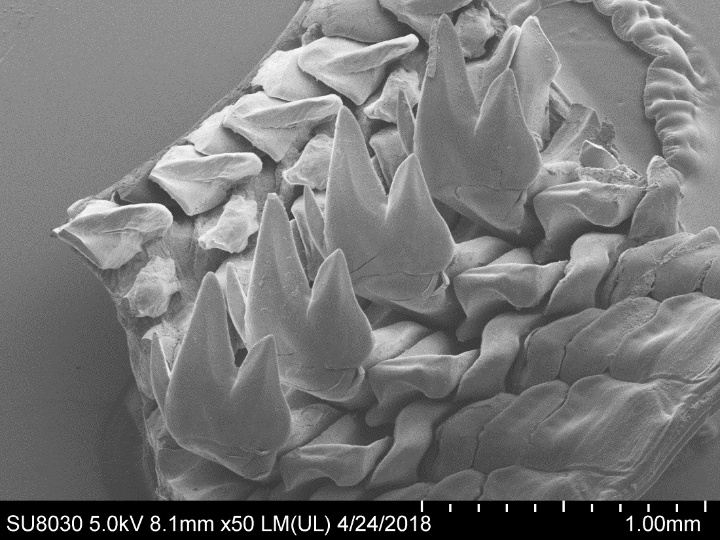During his stay at Northwestern University in the United States, funded by the German Research Foundation (DFG), chemist Dr. Linus Stegbauer worked with Professor Derk Joester's research group, detecting and studying the rare mineral santabarbarait in a living organism for the first time. The team has now published an article about this, with Stegbauer as the lead author, in the renowned scientific journal "Proceedings of the National Academy of Sciences" (PNAS). Stegbauer currently works at the University of Stuttgart's Institute of Interfacial Process Engineering and Plasma Technology IGVP. Experts in biological hard materials at the University of Stuttgart are now continuing his research, with the aim of developing new bio-inspired structural materials.
At first glance, the marine chiton (Cryptochiton stelleri) appears a little misshapen, which might explain why it is nicknamed the wandering meatloaf. But something astounding is hidden behind its inconspicuous facade: the teeth on its rasping tongue (radula), which it uses to scrape algae from rocks, are made of a special material which contains the rare iron mineral santabarbarait. This gives the teeth roots a tremendous rigidity, making them one of nature's hardest materials. At the same time, the teeth are connected to a flexible and soft radula, which ensures a high level of flexibility. This means that mollusks are perfectly adapted to their environment and don't lose their teeth on the rocks.
Led by Derk Joester, Professor of Materials Science and Engineering at the McCormick School of Engineering at Northwestern University in Evanston near Chicago, a research team at the university conducted the first intensive scientific study of the tooth root material and made the astonishing discovery that it contained santabarbarait. "Until now, this material has only been found in tiny amounts in geological samples and it has never before been found in a biological context", explains Joester.
For the analysis of the teeth material, the project team is working together with Ercan Alp from Argonne National Laboratory, and others. The laboratory has an Advanced Photon Source in Lemont (Illinois, USA) with a synchrotron for conducting Mößbaue spectroscopy, and was thus able to provide the scientists with the necessary infrastructure for their investigations.
The researchers determined that the teeth material has a high water content, which also makes it tremendously strong, while maintaining a low density. They assume that this makes the teeth harder and stronger, without increasing their weight. These special characteristics make the teeth interesting for the field of applied materials science. Based on the minerals that have been found in the teeth, the researchers at Northwestern University developed a bio-inspired "ink" for 3D printers from hard, rigid and durable materials.
The scientists have described the study in a scientific article, which was published on June 1, 2021, in the scientific journal "Proceedings of the National Academy of Sciences", one of the most prestigious journals in the world. Alongside Joester as corresponding author, IGVP-scientist Stegbauer also made a major contribution to the publication as lead author. He researched at the McCormick School of Engineering from 2016 to 2019, a placement made possible by a research scholarship from the DFG, before moving to the IGVP in Stuttgart in 2019 to establish his own research group focusing on "Bioinspired Material Chemistry". His research continues to draw on his work at Northwestern University.
The study "Persistent polyamorphism in the chiton tooth: From a new biomaterial to inks for additive manufacturing" was supported by the National Science Foundation (grant references DMR-1508399 and DMR-1905982), the National Institute of Health (NIH-DE026952), the Air Force Research Laboratory (FA8650-15-2-5518) and the German Research Foundation (STE2689/1-1).
Expert Contact:
Dr. Linus Stegbauer, University of Stuttgart, Institute of Interfacial Process Engineering and Plasma Technology IGVP, +49 711 685-65595, email
Press information from Northwestern University, May 31, 2021
Proceedings of the National Academy of Sciences, edition from June 1, 2021
IGVP research field Bioinspired Material Chemistry
In the media:
New York Times: "How the ‘Wandering Meatloaf’ Got Its Rock-Hard Teeth", May 31, 2021
Stegbauer Lab:
Contact

Linus Stegbauer
Dr.Principal Investigator Bioinspired Material Chemistry



